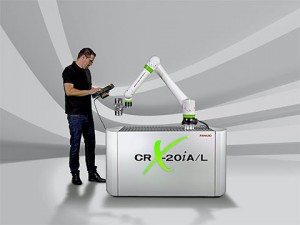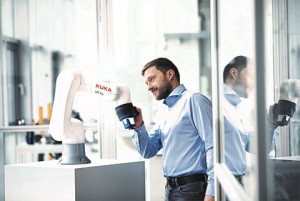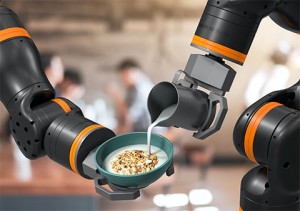Cobots and no-code: robotics for all at Automatica
 With just under three months to go until Automatica, which will be held on the grounds of Messe München from June 21 to 24, one thing is for sure: never before has there been such a wide range of collaborative robots on show. And they are easier to operate than ever. The same also applies to industrial robot, with ‘no-code robotics’ coming to the fore.
With just under three months to go until Automatica, which will be held on the grounds of Messe München from June 21 to 24, one thing is for sure: never before has there been such a wide range of collaborative robots on show. And they are easier to operate than ever. The same also applies to industrial robot, with ‘no-code robotics’ coming to the fore.
This and many other developments pursue a common goal: the democratisation of robotics. In the future, anyone should be able to operate robots without special skills. In cobots, this has already been implemented with simple programming options. And the straightforward integration and operation of these devices are key reasons for their popularity.
The cobot market is seeing considerable growth. For example, Universal Robots has already deployed more than 50,000 cobots in all kinds of applications. Kim Povlsen, managing director of the Danish company, put the sales potential for cobots at around nine million units, and he sees the industry on a trajectory to billions of Euros in turnover.
It comes as no surprise, then, that numerous vendors are pushing cobots. While some qualify their standard robots for direct human-robot interaction by integrating numerous safety features, others focus on the development of special lightweight robots. Visitors to Automatica in Munich can see the advantages and disadvantages of both worlds for themselves. However, the hype is clearly on lightweight cobots.
Fanuc will be presenting three new cobot models characterised by lightweight design and intuitive drag-and-drop programming, which are likely to generate particular interest among first-time users. In order to meet increasing demand, Fanuc is going beyond just ramping up production capacity. Shinichi Tanzawa, CEO of Fanuc Europe, is pursuing another goal: “We want to become the undisputed market leader for cobots in Europe.”
 It remains to be seen what other market players think of this. Kuka, for example, with its LBR iisy, is presenting a cobot that it anticipates will set operational benchmarks thanks to its brand-new operating system. Kuka’s promise: set it up, switch it on, get started.
It remains to be seen what other market players think of this. Kuka, for example, with its LBR iisy, is presenting a cobot that it anticipates will set operational benchmarks thanks to its brand-new operating system. Kuka’s promise: set it up, switch it on, get started.
ABB makes similar promises. The new GoFa and SWIFTI cobot families are also said to be particularly easy to operate, while featuring high payloads and speeds. “Our new cobot portfolio is the most versatile one on the market,” says Sami Atiya, head of ABB Robotics and Discrete Automation.
Yaskawa will present its HC DTP cobot series at Automatica under the slogan ‘Easy–Smart–Fenceless’. With the new Yaskawa ecosystem, the company offers a variety of proven supplied and in-house plug-and-play products that enable its customers to design their own modular cobot cell.
Newcomers and start-ups
Those who may think that only the large industrial robot manufacturers are capable of designing cobots will be proven wrong at Automatica. The number of new manufacturers that are young or hail from other industries is growing exponentially – and the speed of innovation in the shape of various cobot variants for all kinds of applications is picking up accordingly.
 For example, Igus, previously best known as a manufacturer of energy-conducting chains, will be exhibiting the attractively priced ReBeL plastic cobot, which weighs around 10kg and reduces entry barriers to a minimum. Hence, this machine will predominantly be used in simple applications where the use of robotics used to be unprofitable.
For example, Igus, previously best known as a manufacturer of energy-conducting chains, will be exhibiting the attractively priced ReBeL plastic cobot, which weighs around 10kg and reduces entry barriers to a minimum. Hence, this machine will predominantly be used in simple applications where the use of robotics used to be unprofitable.
Between low-cost and high-end, manufacturers from all over the world – including Comau, Denso, Doosan, Franka Emika ,Kassow, Omron, Rethink, Stäubli, Techman and many more – will present cobot solutions for all kinds of applications. And last but not least: Germany’s most valuable robotics start-up Agile Robots will also be exhibiting at Automatica.
Low-threshold entry into robotics
Programming for traditional industrial robots is also on the verge of a small revolution. Wherever applications allow it, new methods will replace traditional high-level language programming in the future. The purpose of this is not just to provide newcomers with a low-threshold entry into robotics. This is more about no-code robotics’ potential to reduce programming time dramatically in many applications.
This is what Wandelbots, for example, is promising. With its pen-based programming, the start up from Dresden is turning the world of programming upside down. For example, to program a welding path, the user simply draws it with the so-called TracePen. Anyone can do it and it’s breathtakingly fast. It also saves costly programming time.
Epson is another manufacturing coming to Munich to present a no-code programming environment for robotics beginners with little or no expertise. It enables quick and easy operation of the manufacturer’s four-axis robots.
Fruitcore Robotics is taking another interesting approach by tailoring robot programming to different levels of user capability. The company now offers four software packages for its Horst robots: Starter, Professional, Digital, and Premium. Users can simply book a different package as requirements change. This maximises flexibility and ensures that future needs will be met.
Visit the Automatica website for more information
See all stories for Automatica















